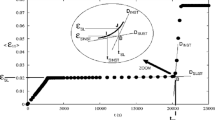Abstract
A fragmentation specimen consists of a single fibre embedded along the axis of a long narrow resin block. When the fibre is broken by a tensile load, either a lateral crack runs outwards into the resin, initiated by the break, or a debond (or equivalently a cylindrical crack in the resin) propagates along the fibre. Debonding always occurs with thin fibres. Strain energy release rates have now been calculated, analytically for long debonds and by FEA for short ones. The force to propagate a debond is found to increase as the debond grows, reaching a final value, termed “pull-out force”, that is higher for softer fibres. If this force exceeds the strength of the fibre, then the fibre breaks again. This is the proposed mechanism of fibre fragmentation. For weakly-bonded, stiff fibres, the inferred minimum distance between breaks, i.e. the critical fragment length, is deduced to be of the order of the geometric mean of the radii of fibre and resin block, about 0.1–0.5 mm for typical fragmentation specimens, and it increases as the ratio of fibre stiffness to resin block stiffness increases, in agreement with observation.
Similar content being viewed by others
References
A. Kelly and W. R. Tyson, J. Mech. Phys. Solids 13 (1965) 329.
A. N. Gent, G. S. Fielding-Russell, D. I. Livingston and D. W. Nicholson, J. Mater. Sci. 16 (1981) 949.
A. N. Gent and G. L. Liu, ibid.— 26 (1991) 2467.
A. N. Gent and O. H. Yeoh, ibid.— 17 (1982) 1713.
A. N. Gent and S. Y. Kaang, Rubber Chem. Technol. 62 (1989) 757.
A. T. Dibenedetto and P. J. Lex, Polym. Eng. Sci. 29 (1989) 543.
W. D. Bascom and R. M. Jensen, J. Adhesion 19 (1986) 219.
C. Baxevanakis, D. Jenlin and D. Valentin, Comp. Sci. Tech. 48 (1993) 47.
A. N. Netravali, P. Schwartz and S. L. Phoenix, Polym. Compos. 10 (1989) 385.
E. I. M. Asloun, M. Nardin and J. Schultz, J. Mater. Sci. 24 (1989) 1835.
A. N. Gent and C. Wang, J. Mater. Sci. 27 (1992) 2539.
Idem, ibid.,28 (1993) 2494.
J. G. Williams, “Fracture Mechanics of Polymers” (Wiley, New York, 1984) p. 30.
K. J. Bathe, “ADINA: A Finite Element Program for Automatic Dynamic Incremental Non-Linear Analysis”, Report No. 82448-1 (Massachusetts Institute of Technology, Cambridge, Massachusetts, 1987).
M. Nardin, A. El Maliki and J. Schultz, J. Adhesion 40 (1993) 93.
Author information
Authors and Affiliations
Rights and permissions
About this article
Cite this article
Gent, A.N., Chang, Y.W., Nardin, M. et al. Mechanics of fibre fragmentation. Journal of Materials Science 31, 1707–1714 (1996). https://doi.org/10.1007/BF00372182
Received:
Accepted:
Published:
Issue Date:
DOI: https://doi.org/10.1007/BF00372182




